“Digital marketing” is a relatively new term that has rapidly come into prominence over the last decade, and as Ron Burgundy might say… “It’s kind of a big deal.”
To provide the simplest definition, digital marketing is an umbrella term for the marketing of products or services using digital technologies.
Online marketing is by far the most important segment of digital marketing. As traditional channels like TV and radio become less and less valuable, online marketing continues to take up bigger and bigger segments of companies’ marketing budgets, with millions of businesses marketing exclusively via the Internet.
Consider this post an introduction to digital marketing—Digital Marketing 101, if you will—which breaks down the most common channels and gives you a comprehensive framework for understanding this ever-evolving industry.
What Is the Purpose of Digital Marketing?
Like any form of marketing, the purpose of digital marketing is to promote and sell a product or service. More specifically, the purpose of digital marketing is to connect a business or organization with its target audience via digital channels.
There are currently over 3.3 billion Internet users worldwide, with this number increasing every day. Technological device ownership continues to increase as well, with 92% of U.S. adults owning at least a cellphone.
.

The goal of digital marketing is to utilize these numerous devices, often via the Internet, to connect segments of users with relevant businesses. Marketers will use a variety of methods to target and reach out to users in order to grab their attention and begin the process of selling to them.
And thanks to the increased use of these digital devices, businesses around the globe are increasingly making digital marketing their primary focus:
- 71% of companies plan to increase their digital marketing budgets this year (Source: Webbiquity)
- On average, 60% of a marketer’s time is devoted to digital marketing activities, fueling demand for digital marketing skills (Source: Smart Insights and Ecommerce Expo)
- One third of businesses are planning to introduce a Digital Transformation program and one third already have (Source: Smart Insights and TFM&A)
- Digital content creation and management now claim the second-largest share of digital marketing budgets (Source: KaPost)
- 28% of marketers have reduced their traditional advertising budget to fund more digital marketing (Source: CMO Council)
- 73% of B2B marketers use video as a content marketing tactic, and 7% of marketers plan on increasing their YouTube marketing (Source: Content Marketing Institute)
One of the things that separates digital from traditional marketing is the capabilities of modern technology. Digital marketers are focused primarily on targeted, measurable activities. They want to zero-in on the “right” audience and measure the results of their efforts. In the past, targeting looked like taking out a regional TV ad or running an ad in a niche magazine, but today’s technology allows for a much more refined, measurable approach.
For example, a digital marketer today can run a Facebook advertisement targeting only 20-year-olds interested in the band Coldplay. They can see every view, like, comment, and click and then use a tracking pixel to see exactly what people do after they click on the ad. This data can then be used to create ads that perform better.
The Digital Conversion Funnel
In order for us to dig into the various digital marketing channels themselves, we first need to understand the overall process in which they fit.
Digital marketing is typically built around acquiring and funneling users through a “sales” or “conversion” process often referred to as a “funnel.” The basic Digital Conversion Funnel looks like this:
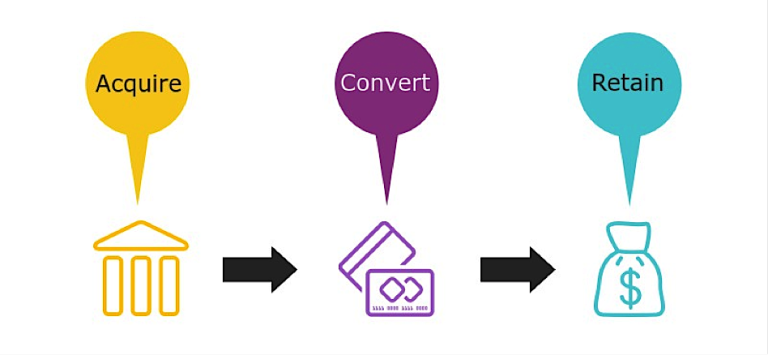
At its most basic, this process is a simple progression from acquisition to conversion to retention. This model is fairly universal and can be applied to virtually any business. Leads are acquired, converted to customers, and then retained for additional transactions.
As we get more detailed, we begin to exclude certain business models, but for the sake of reference, the most common digital conversion funnel currently in use looks something like this, taken from Digital Marketer’s guide to CVO:
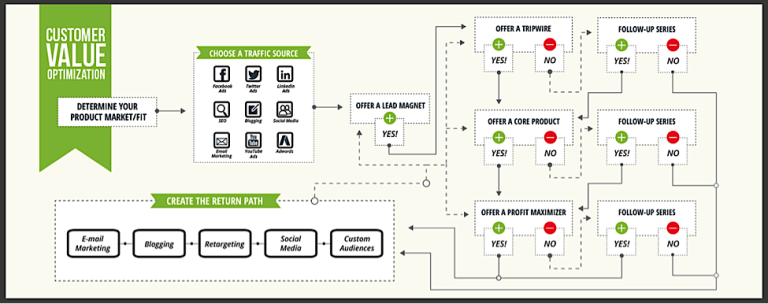
Unlike traditional marketing which is focused primarily on new customer acquisition, digital marketing is highly active throughout the entire conversion process. Once you’ve acquired new leads, you must continue to market to them in order to convert them into a customers and upsell them on additional products.
Acquisition: Common Channels For Acquiring Traffic
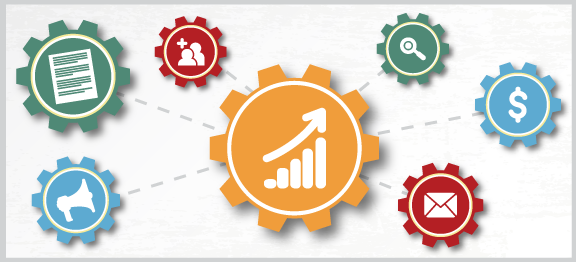
Since businesses can’t take people through their full sales process on Facebook, Google, etc., the first step for most digital marketers is getting people to visit their website. This is called acquiring “traffic,” and it’s the first step of the conversion funnel we mentioned earlier.
There are currently 7 primary channels used to acquire traffic:
- Search Engine Optimization
- Paid Advertising
- Social Media Marketing
- Email Marketing
- Content Marketing
- Influencer Marketing
These channels offer businesses a scalable way to acquire and increase traffic over an indefinite period of time. Furthermore, they have become so prominent that it would be fairly easy to find a full-time job specific to any one of these categories.
Let’s take a closer look at each channel.
1. Search Engine Optimization (SEO)
Search Engine Optimization (SEO) is the process of maximizing the number of visitors to a particular website by ensuring that the site appears high on the search engine results pages (SERPs).
For example, if you wanted to make a rock climbing website appear first on the SERPs when someone searches for “rock climbing gear,” the techniques and processes you use to attempt that would be called SEO.
Search engines work by using software applications called “crawler bots” to systematically browse the web and send back information on the millions of browsed pages. This data is then indexed via the search engine’s algorithm in order to provide relevant results when a user searches for a given keyphrase.
When Google launched in 1998, its PageRank system provided a new level of relevancy for keyphrase search results, and by 2000 it had become THE search engine to use, a position it maintains to this day:
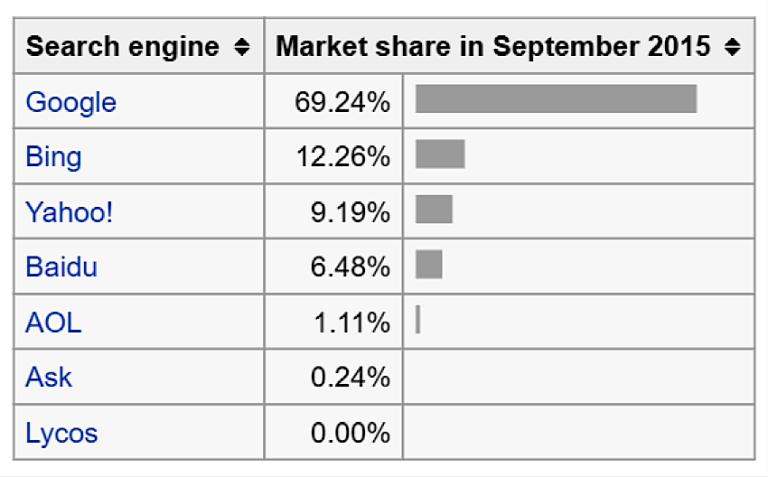
SEO was one of the first dedicated marketing channels to revolutionize how businesses approached online marketing. Some consider it to be THE first meaningful online marketing channel.
While SEO has changed drastically within the last 10 years, modern practices can be broken down into two significant sections:
- On-Page SEO
- Off-Page SEO
On-page SEO is the practice of optimizing individual web pages in order to rank higher and earn more relevant traffic in search engines. On-page refers to both the content and HTML source code of a page that can be optimized.
In other words, on-page SEO covers everything you can do on your own website to improve search engine visibility.
Common on-page SEO techniques include:
- SEO-friendly permalink URLs
- Keyphrase optimized meta tags
- Multiple media types targeting same keyphrase
- Authoritative outbound links
- Improving site loading speed
- Internal cross-linking
- Lengthy, in-depth content
These techniques tune a website’s content and framework to help provide crawler bots with the correct information.
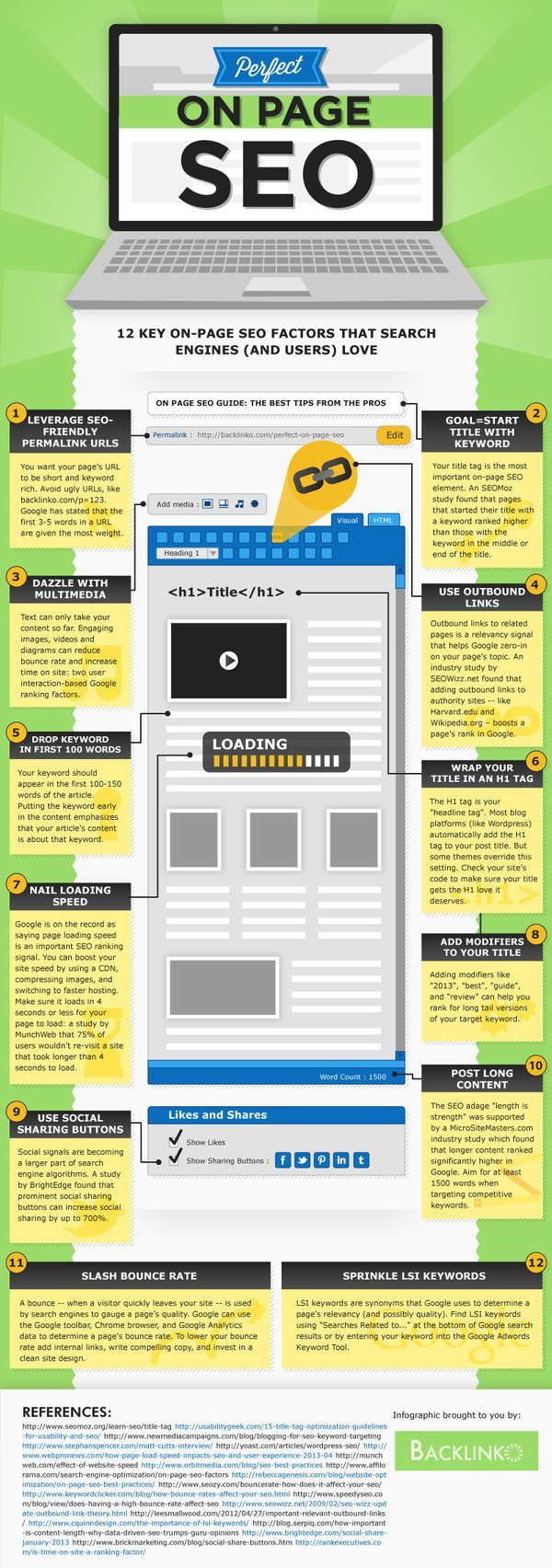
(Source: Backlinko)
To learn more about on-page SEO, check out these guides:
A Visual Guide to Keyword Targeting and On-Page SEO by Rand Fishkin
On-Page SEO: Anatomy of a Perfectly Optimized Page by Brian Dean
Off-page SEO is the practice of optimizing a website’s search engine visibility through off-site backlinks and other external signals. Branding and overall web presence play a role in this equation, but by far the biggest component of off-page SEO is generating backlinks.
Part of what made Google’s PageRank so revolutionary was the inclusion of external factors, namely backlinks, into the ranking algorithm. Google’s founders hypothesized that if tons of other websites were linking to a page (called a backlink), it must be a valuable resource and one that search engines users would want to find as well.
In the early days, SEO practitioners would game the system by creating thousands of websites for the sole purpose of sending backlinks to the website they wanted to optimize. As Google’s algorithm has evolved, however, the vast majority of these practices have been rendered ineffective, and now backlinks from legitimate, authoritative sites are needed in order to improve search rankings.
Effective strategies for grabbing more backlinks, also called “link building,” include:
- Writing guest posts
- Creating shareable infographics
- Get included in resource lists and directories
- Write and promote case studies
- Sponsor sites that will link to sponsors
- Buy listings with trust mark brands like BBB or Truste
- Offer your website to replace dead links
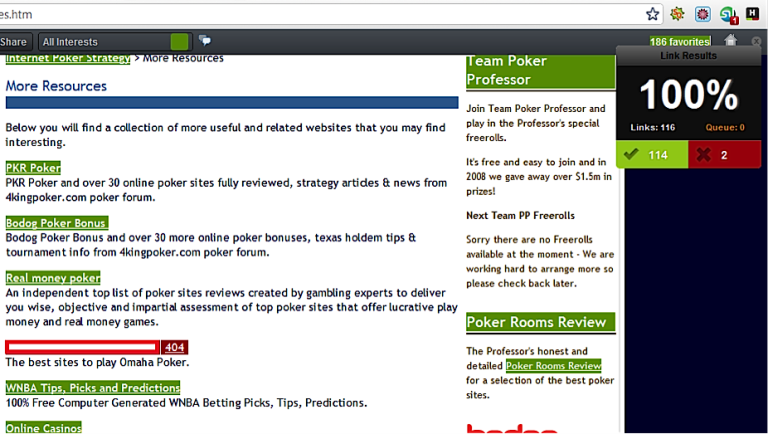
These techniques (and many others) will increase the number of sites linking to your site, which will improve your site’s prominence in relevant search results.
For additional resources on link building, click on the links below:
Link Building Tactics: The Complete List by Jon Cooper
Ultimate Guide to Link Building with Content by Eric Siu
2. Paid Advertising & Acquisition
Paid acquisition is any form of advertising or traffic acquisition in which a business pays directly for incoming traffic.
The most common pricing models for paid acquisition include:
- Cost Per Impression (CPM)
- Cost Per Click (CPC)
- Cost Per Lead (CPL)
With Cost Per Impression (CPM), advertisers pay for ad views, typically in units of 1,000 views, which is where the CPM acronym comes from. CPM stands for “cost per mille” (“mille” is Latin for “thousand”).
CPM was traditionally the preferred strategy for getting maximum views at a low cost. However, with the rise of bot traffic (nearly 60% of all web traffic now comes from bots) and the arrival of better performing channels, CPM has fallen out of favor in the digital marketing world.
Today, CPM is typically only used in conjunction with other models. It offers a low-cost way to increase brand awareness, and can yield minor results if targeted at the right audiences.
With Cost Per Click (CPC), advertisers pay every time their ad is actually clicked on by a viewer. CPC, more commonly referred to as “pay per click (PPC)”, allows for direct ROI tracking, making it the most popular pricing model currently used in online marketing.
CPC is often used in conjunction with a search engine, where ads can be displayed to users searching for a specific keyphrase. For example, a business could use AdWords to place a “Purchase Rock Climbing Gear” ad in Google’s search results anytime someone searches for “rock climbing gear.”
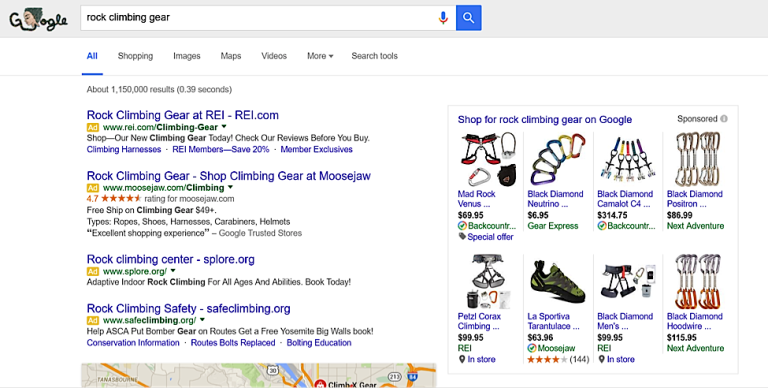
While a business’ SEO efforts might not be enough to get them on Google’s front page, they could guarantee a front page spot via AdWords if they are willing to pay enough per click. Adwords and other PPC platforms are typically run on a bidding system, where advertisers select a bidding range and the platform dynamically selects ads to display based on a combination of factors including bid price and page relevance.
More recently, CPC ads on social networks like Facebook, Twitter, and LinkedIn have begun to gain traction as well, and some have even become the preferred advertising option for certain industries.
To learn more about CPC/PPC, check out the guides below:
The PPC Food Pyramid: A 211 Point PPC Marketing Strategy by Johnathan Dane
PPC – The Ultimate Guide To Pay-Per-Click Marketing by Matt Umbro
Cost Per Lead (CPL) typically refers to how much it costs a business to generate or acquire a lead. CPL tends to be used more as a metric for other strategies like PPC, but it can also apply to paid lead acquisition, which is what we are talking about in this section.
Paying directly for leads tends to only makes sense in industries where customers spend high amounts per transaction or session.
Industry examples include:
- Insurance
- Travel
- Gambling
- Debt Consolidation
- Financing
For most businesses, it makes more sense to simply target traffic and set up their own lead capture system to convert traffic into leads and then customers.
3. Social Media Marketing
Social media marketing is the process of acquiring attention and website traffic through social media platforms. With the consistently increasing popularity of social media, social media marketing has become one of the quickest ways for new businesses to generate traffic without any monetary expense.
As we mentioned before, digital marketing is all about getting a business in front of its target audience. With 65% of US adults now using social media, chances are very high that your target audience can be reached through a social platform.
Social media provides businesses with a direct line to their target audience and customer base. By building a social community around their brand and niche, businesses can directly engage and interact with customers on an unprecedented level.
Businesses can utilize social media to:
- Build an interactive niche community
- Attract direct traffic to website pages
- Collect feedback and monitor audience response
- Validate new promotions or product ideas
- Handle customer service directly
- Identify potential candidates for hiring
In addition to these benefits, social media is also capable of producing both direct and indirect revenue for online businesses. This is evidenced by the increasing amounts ROI-conscious companies are investing in social media marketing:
| Overview | Values | Statistic |
|---|---|---|
Worldwide social media revenue |
$16.9bn | Details → |
Social media marketing expenditure in the U.S. |
$7.52bn | Details → |
Forecasted social media marketing spending in the U.S. by 2019 |
$17.34bn | Details → |
Advertising revenue of social networks worldwide |
$25.14bn | Details → |
To learn more about using social media as a business or organization, check out these resources:
The Beginner’s Guide To Social Media by Moz
The Social Media Handbook – 57 Resources For First Time Entrepreneurs by Neil Patel
4. E-mail Marketing
E-mail marketing is the process of sending direct marketing communications to users via e-mail. It is generally considered to have the highest ROI of any digital marketing channel, with an average ROI of $38-42 per dollar spent.

By building a list of e-mail subscribers, companies are able to keep in continuous contact with their audience and bring new offers, products, or announcements to their subscribers’ attention at any time. And for some reason, despite how “outdated” e-mail is as a technology, e-mail subscribers continue to engage with businesses at an incredible rate, as the following stats curated by Campaign Monitor show us:
- You are 6x more likely to get a click-through from an e-mail campaign than you are from a tweet. (Source: Campaign Monitor)
- E-mail is 40x more effective at acquiring new customers than Facebook or Twitter. (Source: McKinsey)
- 81% of online shoppers who receive e-mails based on previous shopping habits were at least somewhat likely to make a purchase as a result of targeted e-mail. (Source: eMarketer)
- When it comes to purchases made as a result of receiving a marketing message, e-mail has the highest conversion rate (66%) when compared to social, direct mail, and more. (Source: DMA)
- E-mail subscribers are 3x more likely to share your content via social media than visitors from other sources. (Source: QuickSprout)
- 72% of people prefer to receive promotional content through e-mail, compared to 17% who prefer social media. (MarketingSherpa)
- Including a call to action (CTA) button instead of a text link can increase conversion rates by as much as 28%. (Source: Campaign Monitor)
- E-mail marketing drives more conversions than any other marketing channel, including search and social. (Source: Monetate)
- A message is 5x more likely to be seen in e-mail than via Facebook. (Source: Radicati)
- 4.24% of visitors from e-mail marketing buy something, compared to 2.49% of visitors from search engines and 0.59% from social media. (Source: Monetate)
- Sending four e-mails in a month instead of one significantly increases the number of consumers opening more than one e-mail. (Source: WhoIsHostingThis)
The basic e-mail marketing process looks like this:
While e-mail can be used as a standalone marketing channel, it is often used as a key cog in lead conversion and customer retention, which we will get to later. It is also a mandatory component of the broader acquisition channel known as content marketing.
For in-depth guides to building and monetizing an e-mail list, check out these resources:
21 Powerful Ways To Quickly Grow Your Email List
4 Reasons Why You Should Be Pushing E-mail Marketing
5. Content Marketing
Content marketing is the marketing and business process for creating and distributing relevant and valuable content to attract, acquire, and engage a clearly defined and understood target audience—with the objective of driving profitable customer action.
In other words, content marketing is all about creating and promoting content that is really attractive to the audience you want to sell to.
This content can come in a number of formats:
- Blog Articles
- Videos
- Ebooks
- Visual Guides
- Webinars
- E-mails
- Infographics
- Podcasts
- Case Studies
- Interviews
Content marketing has gained popularity as Google’s algorithms have become more advanced. Whereas in the past it was more efficient to game the system with spammy SEO practices, nowadays, top-quality content is required to have any sort of SEO success.
Indeed, quality content has become a crucial component of virtually every acquisition channel listed here. But ultimately, more and more businesses are moving past simply using content in other strategies and approaching “content marketing” as an intentional digital marketing strategy built around the creation and promotion of exceptional (or 10x) content.
- Marketers who prioritize blogging are 13x more likely to achieve a positive ROI on their efforts. (source)
- 88% of B2B marketers currently use content marketing as part of their marketing strategy. (source)
- 76% of B2B marketers say they will produce more content in 2016. (source)
- 77% of B2C marketers say they will produce more content in 2016. Only 2% will produce less. (source)
- Content marketing budgets have increased among B2C companies this year: on average, 32% of total marketing budgets are going towards content, compared to 25% last year. (source)
- A majority (60%) of B2B marketers report that their top challenge in 2016 will be producing engaging content. 57% say measuring content effectiveness will be their greatest challenge, and 57% say producing content consistently will be their biggest struggle. (source)
- 45% of marketers say blogging is their #1 most important content strategy. (source)
As we mentioned before, the content marketing loop is centered around content, but it uses multiple channels. The content marketing process is essentially the same as the digital marketing process we discussed previously:
- Acquire traffic by promoting content across all channels
- Convert incoming traffic into e-mail subscribers
- Nurture and convert subscribers to customers via e-mail marketing
- Retain, nurture, and retarget customers via e-mail and new content
For more information on content marketing, check out these resources:
10 Content Marketing Myths that Are Killing Your Conversions by Eric Siu
Contently CCO Shane Snow Reveals One Trick To Instantly Skyrocket Your Content Marketing by Growth Everywhere
6. Influencer Marketing
Influencer marketing is the process of targeting key influencers in a given niche with the goal of getting your business in front of their audience.
As the Internet has grown and evolved, more and more individuals, blogs, organizations, and businesses have built audiences large enough to qualify them as “influencers.” This increasing collection of pre-built audiences has allowed influencer marketing to become a viable acquisition channel for the first time in recent years, and it saw a significant increase in mainstream popularity in 2015.
An “influencer” is essentially anyone with a relatively large online following.
Influencers can be:
- Celebrities – known by everyone in their industry
- Authorities – views respected by anyone “in the know”
- Journalists – write for multiple high-traffic publications
- Connectors – know and work with all the key players
- Bloggers – host medium-sized but highly-engaged communities in their niche
People in each of these categories either own or have direct access to sizable audiences. By targeting them, brands can get their product, service, or content in front of a large audience without having to build that audience themselves.
Unlike the other acquisition strategies we’ve covered, influencer marketing is not scalable in the long run. It is, however, an insanely effective “growth hacking” tool for kickstarting early businesses’ growth in a big way. Since most businesses fail in the first year, an effective influencer marketing campaign can be the difference between going belly up and getting the required initial traction to reach profitability.
Influencer marketing can take on a number of forms, depending on what you are hoping the influencer will do for you business, such as:
- Craft content with the goal of having the influencer share your content
- Create a revenue-split offer with the goal of bringing on the influencer as an affiliate
- Send intriguing information with the goal of having the influencer publish something about you or your business
- Offer your own audience with the goal of getting exclusive content (like an interview) from them
Unlike other acquisition strategies, there are really no cut-and-paste methods for connecting with high-level influencers. You are dealing with people who get contacted constantly, so connecting with them is often more of an art than a science.
If you want to take the plunge anyway, here are some great guides to help you better understand influencer marketing:
Become a Super Connector: How to Work With 1,000+ Influencers by Jason Quey
Influencer Networking Guide: 35 Ways to Connect with Anyone Through Social Media by Andy Crestodina
Conversion: Turning Traffic Into Customers
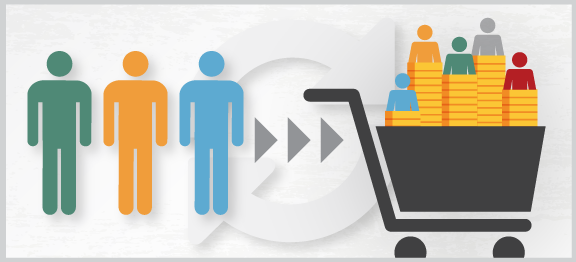
Once you’ve brought visitors to your website via the various acquisition channels we just covered, it’s time to “convert” them to customers. The word “conversion” refers to a visitor taking a specific action upon reaching your website. It’s the goal set for that visitor and the metric by which success is measured.
In some cases, the intended action is a purchase. In this case, visitors are “converting” by purchasing a product and the number of “conversions” is identical to the number of sales.
But conversions are not limited to sales. A business can decide to make any of the following actions the conversion target in place of an immediate sale:
- Visitor calls business
- Visitors subscribes to e-mail list
- Visitor registers for free trial
- Visitor downloads lead magnet
- Visitor makes a donation
- Visitor fills out detailed form
Website owners and marketers will attempt to maximize the number of visitors who act or “convert” in the above ways through a process called conversion rate optimization.
Conversion Rate Optimization (CRO)
Conversion Rate Optimization (CRO) is a systematic approach for increasing the percentage of visitors to a website who take a desired action. CRO utilizes analytics, user feedback, and other insights to help businesses make the most of their existing traffic by defining, refining, and meeting key objectives via their webpages.
To put it simply, CRO is the process of maximizing the performance of your website so that more of your visitors do what you want them to do.
How? While CRO involves a systematic process that adapts to the specific site, changes are often targeted at some of these key page elements:
- Copywriting – the wording, language, tone, and content of the page
- Design – using visuals to enhance the message
- Navigation – getting visitors quickly and intuitively to the CTA
- Call To Action (CTA) – compelling visitors to take the desired action
CRO is important because it’s one third of your revenue equation. For a website seeking to make money, the basic revenue equation looks like this:
Traffic x Conversion Rate x Price = Revenue
1,000 visitors per day (x) 5% conversion rate (x) $10 = $500
In order to increase revenue, we can increase any one of these 3 equation variables: traffic, conversion rate, or price.
We covered traffic acquisition already so you know that each of those channels entails a cost, whether that cost is money, time or a mixture of both. Scaling up traffic can be expensive, particularly if that traffic isn’t converting once it reaches your site.
Increasing price is a possibility, but you probably picked your existing price for a reason and simply increasing isn’t always an option.
That leaves your conversion rate. CRO is so important because even just a small increase can have a significant impact on your revenue. If you use a CRO tactic to improve your site’s copywriting and increase conversions from 5% to 7%, you will improve your revenue by 40%, from $500 per day to $700 per day.
Conversion Rate Optimization is an important, emerging field with high demand and limited supply.
- Conversion rates typically range from 1-3%. (Source: Steelhouse)
- Companies typically spend $92 to bring customers to their site, but only $1 to convert them. (Source: Eisenberg Holdings)
- The companies’ satisfaction with their conversion rate has been decreasing in the last four years. Only about 22% of businesses are satisfied with their conversion rates. (Source: Econsultancy)
- About 75% of businesses have a problem finding suitable expertise for optimizing their landing page copy. (Source: MarketingSherpa)
Here’s an example of what CRO can do. Highrise was able to increase its webpage conversion rate by over 100% (doubled revenue) by changing some important parts of the page.

The best CRO specialists use a systematic approach for improving conversions and getting big-time wins like the one pictured above. While every expert has a different method, the basic outline looks a lot like the scientific process:
- Analyze existing data and collect new data
- Hypothesize a set of changes that will improve performance
- Create pages with changes and test their performance against the original (called A/B testing)
- Select winners and repeat the process
If you are ready to dive head-first into the world of CRO, check out these articles:
13 Quick Tricks to Increase Conversion Rates that You Can Do Right Now by Peter Boyle
5 Solutions For Overcoming The Challenges Of Mobile Conversions by UnDelay
Lead Nurturing
As customers become increasingly educated, they spend a lot more time researching before they are ready to make a purchase. Accordingly, many businesses won’t attempt to make immediate sales. Instead, they will try to acquire “leads” and then nurture those leads into sales via the conversion funnel we mentioned earlier.
A “lead” is a visitor who has given you some type of contact information with the expectation that you will be contacting them in the near future. The most common types of leads include people who sign up for an e-mail list, register for a free product version, start a free trial, or call the business for more information.
The exact same CRO process we just discussed is used to to convert leads as well as sales. Unlike sales, however, leads don’t always provide you with any immediate revenue. They must then be taken through an advanced process know as Lead Nurturing in order to turn them into customers down the road.
Why do so many businesses bother with collecting leads instead of going straight for the sale?
There are two answers to this:
- Customer Purchase Cycle
- Customer Lifetime Value
The Customer Purchase Cycle is the process buyers go through when making a purchase. As you will see in the image below, only a small portion of that process is the actual decision-making moment where a purchase is made.
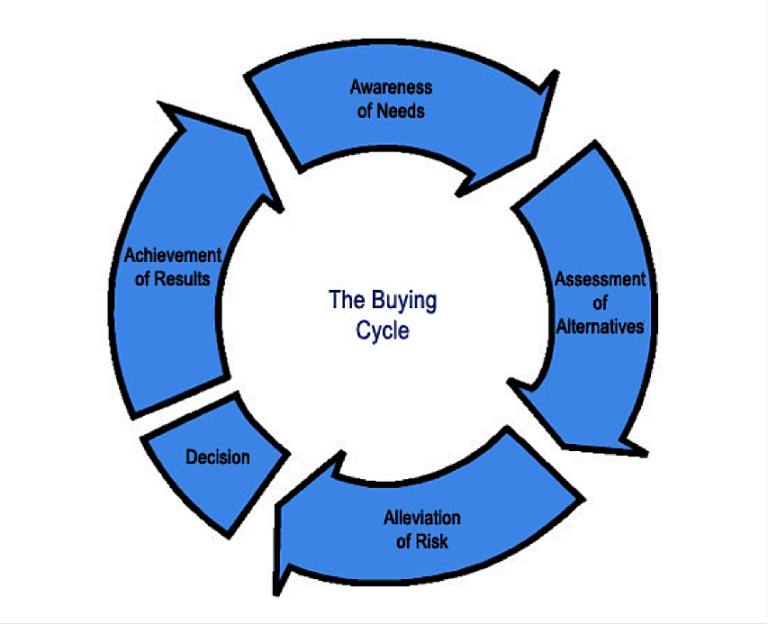
(Source: Kissmetrics)
If you catch a potential customer in the awareness or assessment phases, you have very little chance of converting them right then and there, and unless your branding makes an unforgettable impact or they are conditioned to remember your brand via other means, they will probably forget all about you as they continue through the cycle.
By capturing them as a lead, you can remain in contact with them, build trust/alleviate risk, and keep your brand on their mind so that they are ready to come to YOU when they reach that point of decision.
Another reason businesses opt to focus on leads is Customer Lifetime Value. Existing customers are 5x more likely to buy from a business than new prospects, and repeat customers spend 67% more on average than new customers.
In other words, when you land a customer, the value of that customer is usually far greater than the initial purchase price.
Accordingly, businesses who understand Customer Lifetime Value are willing to invest more in securing new customers. Since new visitors to a website typically convert at around 1-3%, businesses are beginning to pull in a higher conversion rate by collecting e-mail addresses in exchange for intriguing content, tools, or resources, and then using e-mail marketing to nurture those leads into customers.
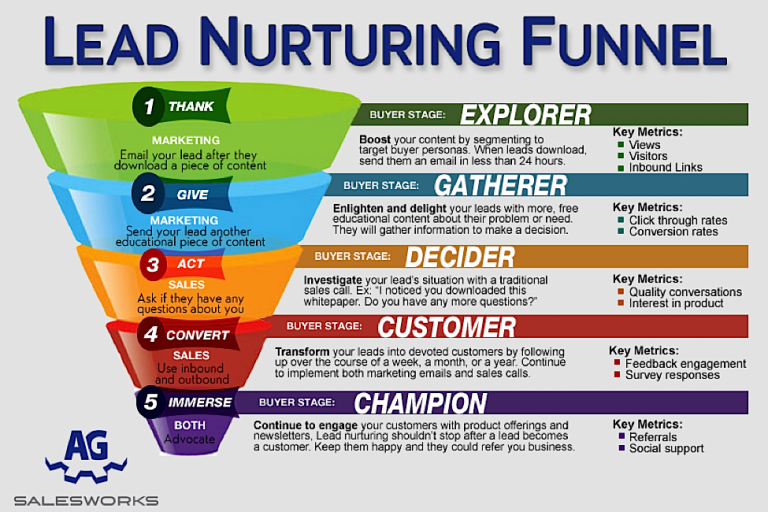
(Source: AG Salesworks)
Lead nurturing, like CRO, is an advanced process with many moving parts. To learn more, check out the resources below:
High-Performing Lead Nurturing & Scoring: The Step-By-Step Guide by Quick-Pivot
The Definitive Guide To Lead Nurturing by Marketo
Retention: Retargeting Existing Customers
The final step in our digital marketing journey is customer retention, and thanks to our previous discussion of Customer Lifetime Value, you’re already primed and ready to go!
As we already mentioned, existing customers are 5x more likely to buy from a business than new prospects, and repeat customers spend 67% more on average than new customers.
This means that retaining and retargeting your growing customer base is paramount to building a successful business!
To do this, we need to set a few goals:
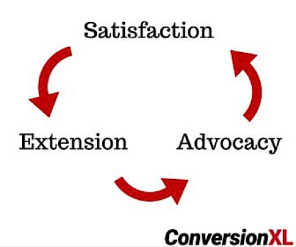
Satisfaction is all about delivering on what customers have already bought. Without meeting this goal, nothing else you do will matter. Delivering a fantastic product or service with timely, effective support is the #1 priority of customer retention.
This is why modern success stories like Buffer have more than a third of their staff dedicated SOLELY to customer service and support. Happy customers are a great formula for growing a business.
Extension is about solving more of your customers’ problems and providing them with additional opportunities to give you money. This could look like upselling them on a more advanced and expensive service plan, offering them supplemental products, or any number of things.
If you get into the mindset of extracting money from your customers, you will fail at retention. The key is to find ways to increase the value that you can provide for them, which will make paying additional money an easy choice.
Advocacy is all about turning your regular customers into brand advocates. This is primarily accomplished via referral programs that reward your regulars for bringing new customers into the fold.
Customers are most motivated to refer friends and family when the rewards go both ways. Try to set up referral programs that provide a meaningful bonus for the both the referrer and the customer being referred.
When setting these retention goals, it’s important to understand where you are aiming in a customer’s lifetime. This process can also be broken down into 3 sections:
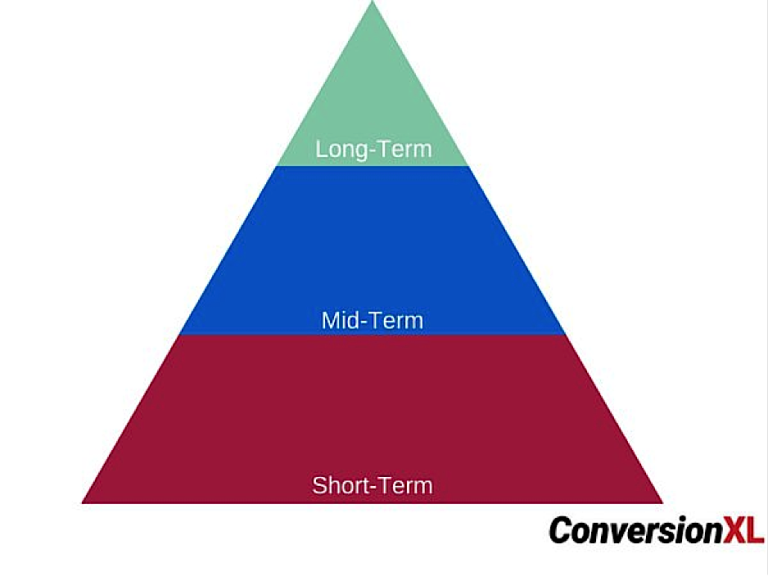
Short-term retention is focused on connecting users with the value your business provides as quickly as possible. You have a limited amount of time to help them use your product or service to meet their goals. If a customer doesn’t have that “YES!” moment within a relatively short time of using your product, they are susceptible to discounting your product/service and never giving it another try.
In addition to a great product/service, intuitive onboarding experience, and fantastic customer support, one of the best ways to impact short-term retention is to create an engaging tutorial or “how to” series that walks new users through the process of learning and actually using your product/service to solve their problems. If you can create an engaging, entertaining tutorial instead of the typical tedious affair, this technique will have a much greater impact on short-term retention.
Mid-term retention is focused on turning your product/service into a regular part of your customer’s process or routine. You don’t want people simply using your product occasionally. You want it to be a vital part of their regular activities, if possible.
In addition to the basics of customer service and support, the best way to impact mid-term retention is through regular education and training. This could look like an e-mail series, blog posts, videos, etc. The content medium isn’t as import as the content itself. Like the tutorials, try to make all educational content engaging, entertaining, and directly related to your product/service.
Long-term retention is focused on following up your initial product/service with a suite of offers that solves many additional problems relating to the initial purchase. You are no longer a product they use. You are now THE brand they go to whenever they need something in this area of their life.
To give a basic example of the retention stages in action, let’s go back to our rock climbing example.
- Short-term retention: Customer bought a beginner’s package of rock climbing gear and absolutely LOVES it!
- Mid-term retention: Customer is rock climbing more often and using the beginner’s gear she bought from you, as well as a few intermediate pieces, whenever she goes climbing.
- Long-term retention: Anytime customer want to learn about rock climbing or purchase something related to rock climbing, she visits your site first.
Retention and Customer Value Optimization are about maximizing the relationship between a business and its customers. And as you can see in the infographic below, this process can utilize every single element of digital marketing we’ve talked about in this guide.

(Source: Digital Marketer)
To dive further into the world of retention and lifetime customer value, check out these two exceptional guides:
Retention Optimization: How To Increase The Value of A Conversion by Shanelle Mullin
Customer Value Optimization: How To Build An Unstoppable Business by Ryan Deiss
Final Thoughts
Digital marketing is a general term for the marketing of products or services using digital technologies, especially Internet marketing, and that’s primarily what we’ve covered today.
The core of the digital marketing process is made of the conversion funnel, which can be broken down into 3 stages:
- Acquisition
- Conversion
- Retention
In a digital world, businesses attempt to attract new visitors through acquisition strategies such as SEO and PPC. Visitors can then be converted into leads and ultimately sales through the conversion funnel itself. Finally, businesses seek to retain these buyers as long-term customers through an intentional retention strategy.
Single Grain is a digital marketing agency that has helped thousands of companies grow their online revenues and scale their growth through a powerful mixture of key traffic acquisition strategies. We’re digital marketing experts so you don’t have to be!
Click here to get your FREE 29-page e-book The Only Guide to Effective SEO You’ll Ever Need.






